The Double Lapel Grab
by Christopher Caile

It is a common attack. An aggressor grabs you -- both of his or her hands
pull in your jacket lapels (or both sides of your shirt). You end up eyeball
to eyeball with emotion -- often accompanied with a vent of expletives
or threats mixed with a spray of spit.
It's scary, perhaps, but the attack is faulty since both hands are occupied
and you are too close to kick easily. The defender, however, has a free
hand, elbow, head, two knees and feet available as weapons.
Of course, watch out for a low knee or a head butt, but often this attack
is one of anger or frustration without the intent to harm, or at least
indecision as to what exactly to do next. So, with this attack you have
a lot of options.
Throughout this series on basic self-defense techniques I have stressed
two basic principles. First, there should be a "continuum of force"
in any self-defense application -- starting with techniques which may
hurt, sting or create the release itself, but that will do no harm to
the aggressor, and progressing through to being able to render the assailant
unconscious, incapacitated or immobilized.
The second critical factor is that any technique should be effective,
easily applied and useful for a weaker person against a stronger one.
(1)
Non-Harmful Releases
| If the grab is non-threatening or some
playful episode, the defender can usually get the attacker to let
go with any number of simple but painful, or other distraction techniques.
Two techniques I especially like in this situation is a simple grab
and twist of the nose (not shown) and an under arm pinch (shown).
See: Ouch!
The Mighty Little Pinch For Self-defense. |
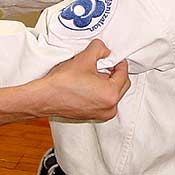 |
| 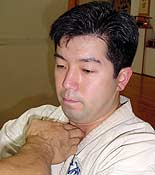 Another
useful (but one step up in escalation) technique is a two finger
downward thrust into the aggressor's jugular notch (attacking the
trachea and the small nerve fibers in this region) (2)
which evokes an involuntary gag reflex away from the pressure. Usually
an attacker will let go and just step away. Another
useful (but one step up in escalation) technique is a two finger
downward thrust into the aggressor's jugular notch (attacking the
trachea and the small nerve fibers in this region) (2)
which evokes an involuntary gag reflex away from the pressure. Usually
an attacker will let go and just step away. 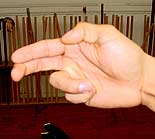 Two
fingers supported by the thumb is fairly strong but also small enough
to access the "V" at the base of the neck. The technique
starts directly in but then turns down. The technique should also
be done quickly. Two
fingers supported by the thumb is fairly strong but also small enough
to access the "V" at the base of the neck. The technique
starts directly in but then turns down. The technique should also
be done quickly.
|
Progressive Techniques
If the double lapel attack is not progressing beyond an additional verbal
assault, the defender has the preferable option of trying to defuse the
situation with rhetoric. But there are times when this just won't work.
Perhaps the grab has been accompanied by a knee, or a second aggressor
is waiting to attack. When it is evident that you must fight back, my
favorite self-defense technique comes right out of the karate Kata Pinan
(Heian) number four. These techniques are designed to be done in a quick,
powerful sequence, but the sequence can be ended at any time. Be careful
if you practice it, and do so only under supervision of a trained expert
in pressure points and resuscitation.
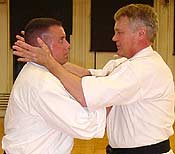 As
the attacker is pulling you inward, you do a double hand technique to
the aggressor's head (both sides). This can be preceded with a loud shout
(kiai) just before you strike that will startle, and thus momentarily
freeze any reaction. As
the attacker is pulling you inward, you do a double hand technique to
the aggressor's head (both sides). This can be preceded with a loud shout
(kiai) just before you strike that will startle, and thus momentarily
freeze any reaction.
There are several target options (3), including
the temples. Here I strike with the base of my hands (shotei) inward and
pulling slightly back toward myself to the edge of the jaw right below
the ears, sometimes known as the mandibular angle point. The strike affects
three major nerves which run together behind the jaw bone under the ear.
(4) This move will stun or knock out the
opponent. Be careful with this strike. You do not have to hit hard.
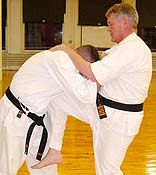 Immediately
drop your hands to the back of the opponent's shoulders and pull
them (rolling them forward and down using your body weight) toward
yourself. Be careful here not to inadvertently pull your opponent's
head into your face (unless your are doing an offensive head butt.
See footnote 3). As your opponent's trunk moves downward thrust
upward (using your hips) with a rear knee kick (when you were pulled
forward one leg usually naturally moves forward to retain balance).
The ideal target is the opponent's solar plexus or other abdominal
target. (5) Immediately
drop your hands to the back of the opponent's shoulders and pull
them (rolling them forward and down using your body weight) toward
yourself. Be careful here not to inadvertently pull your opponent's
head into your face (unless your are doing an offensive head butt.
See footnote 3). As your opponent's trunk moves downward thrust
upward (using your hips) with a rear knee kick (when you were pulled
forward one leg usually naturally moves forward to retain balance).
The ideal target is the opponent's solar plexus or other abdominal
target. (5) 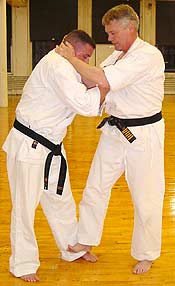 A
natural extension of the hard upper knee action (not shown here)
is to follow with a instep kick to the groin. (6) A
natural extension of the hard upper knee action (not shown here)
is to follow with a instep kick to the groin. (6)
As in the kata (pinan four) the kicking leg is then trust downward
(while you still have your hands on the opponent's shoulders). The
side of your foot near the heel (knife foot or sokuto) is turned
sidewise so the side of the foot hits downward into the arch or
the area of the foot above the toes (metatarsals).
(7) Notice that your techniques so far have followed
a pattern, high, middle and low in quick succession. Now you go
back to high.
|
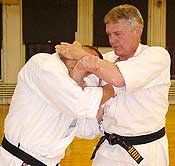 At
this point move (your hands still on the opponent's shoulders) your left
palm upward to strike the side of the opponent's head with the palm and
wrist. This move will hold the head while your right elbow strikes into
the opponent's jaw from the other direction. The head will twist to the
side. The twisting of the body to perform the right elbow strike should
also be transmitted downward into a turn of the right heel (with weight)
just after it has struck downward into the opponent's foot. The twist
itself is capable of causing additional pain or even unconsciousness if
the right area is targeted (see footnote # 7) since it can spread the
long bones of the foot. At
this point move (your hands still on the opponent's shoulders) your left
palm upward to strike the side of the opponent's head with the palm and
wrist. This move will hold the head while your right elbow strikes into
the opponent's jaw from the other direction. The head will twist to the
side. The twisting of the body to perform the right elbow strike should
also be transmitted downward into a turn of the right heel (with weight)
just after it has struck downward into the opponent's foot. The twist
itself is capable of causing additional pain or even unconsciousness if
the right area is targeted (see footnote # 7) since it can spread the
long bones of the foot.
At this point you are turning to face the opposite direction, as in the
kata. Here there is an option. The defender can let go of the attacker's
head and execute (as seen in pinan four) a double knife hand block (the
position of the hands on the head are the same as when cocking the arms
to execute this block). But, the defender can also hold on to the attacker's
head and execute a throw. But this is a very dangerous technique and is
not discussed in the body of this article. (8)
You do not want to cause permanent injury.
Not all these techniques are probably necessary. Hopefully non-harmful
releases will work. And if you have be more aggressive, most often the
first strike into the temples or area behind the ears will end any further
hostilities. But additional techniques are included in case they are needed.
The aim of the side of the head strikes may have been faulty or the attacker
might have been unusually impervious to pain. Thus a quick succession
of techniques have been included to be used if necessary.
Footnotes:
(1) See my Opinion piece: The
Disservice Of Bad Techniques.
(2) The nerves affected are the superior laryngeal and the recurrent
laryngeal.
(3) Several of the options include a double forward
shuto strike (little finger side of the hand) or double palm heel strike
into the sides of the attacker's neck as an attack to the carotid sinuses
(which help regulate blood pressure). This can cause a fast drop in blood
pressure and stun the opponent or cause momentary unconsciousness. Be
very careful with this type technique, however, it is dangerous. If you
practice this pressure point technique, hit very gently, and only when
under supervision of an expert trained in pressure point techniques and
resuscitation. Another variation of this technique uses the fingers of
the hand as guides (on the outside of the neck) to guide the thumbs into
the same target. The technique looks like an upward double knife hand
technique. An especially powerful variation of this technique is described
below. This is explained only for educational purposes (kata bunkai) since
it is a dangerous technique not to be practiced. As the aggressor pulls
you inward, strike with your knee upward to the inside of the attacker's
leg (the groin in a second option) just above the knee (if the attacker
has pulled you in close) which will break his balance (the knee momentarily
losing its power or collapsing) as you strike upward into the side of
the neck. This is immediately followed by your own forehead head butt
into the attacker's nose. This variation can be incorporated into the
sequence of techniques explained above, but should be avoided due to the
danger of the technique. It is included here for those interested in possible
kata applications.
(4) The nerves are the hypoglossal, vagus and
glossopharyngeal. The angle of attack should be into and under the rear
edge of the jaw bone under the earlobe into the head, but slightly backward
toward the nose. Be careful not to forcefully pull back toward yourself
with this strike since it can cause detachment of the jaw. This is one
of the most reliable pressure points on the body, and it will cause intense
pain or unconsciousness if struck with even moderate power. This does
not have to be a hard strike. Practice using one knuckle of the hand lightly
striking a partner who will allow you to test this technique. In French
Savate and some kung fu systems, a cupped hand is used to strike this
area.
(5) Often variations of the two opponent's heights,
how far you have been pulled in and/or how far you have pulled the opponent's
shoulders and trunk into your knee will actually determine the target.
The solar plexus is ideal, but the lower abdomen (below the belly button),
the groin or even the inside of the leg above the knee are also adequate.
This is a powerful technique since you are pulling the opponent into your
thrusting knee counter-attack.
(6) This secondary groin kick is not overtly practiced
in the kata pinan four, but has been shown to me as a hidden technique.
(7) The metatarsals (also found in the hands)
are the long bones that connect ankle and small bones in front of it with
the bones of each toe. The ideal target is to hit with the heel area of
the side of the foot into the area between the metatarsal bone of the
small toe and the fourth toe (about two inches above the web of the junction
of the small and fourth toe). With the weight still bearing down on this
point, even a small twist of the foot (heel) separates the two bones (the
toe metatarsal bone is weak and unsupported by other bones on one side)
and will cause great pain and possibly unconsciousness. During one demonstration
of this technique several years ago, I stepped lightly with my heel on
this point and then turned slightly to address the audience. Immediately
I felt something and heard a thud. I looked back to see my partner on
the floor --out cold. This is an example of causing a neurological overload
- an intense burst of nerve feedback that overloads the brain and causes
a short shut down, or black out. The student didn't remember anything
after feeling a sharp pain in the area of his foot as I turned.
(8) For those who are students of the applications or bunkai found
in kata, consider the following. This follow-up throwing technique is
not to be practiced since it starts with a twisted neck. 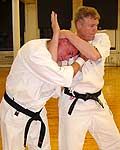 The
movement leverages this position into a takedown or throw that employs
increased twisting action on an already stressed neck. This could cause
permanent spinal injury or even death. Never attempt this technique. If
the elbow strike movement is continued, while the left hand still holds
the side of the attacker's head, the right forearm has moved under the
opponent's jaw and now reaches upward (the crook of the elbow under the
jaw). Using both arms the opponent is now easily pulled forward in a throw-like
action. This not only downs the opponent, but the opponent's body can
be used as a barrier to be maneuvered, or thrown to the ground to trip
a rapidly advancing second opponent. Interestingly, virtually the same
movement used in a two hand shuto block can here also be used to trap
a head and execute a throw. It should be noted, however, that this is
not a throw to be attempted against an unwilling opponent. Instead it
is a finishing technique to be used against someone who is already stunned
or otherwise incapacitated. The
movement leverages this position into a takedown or throw that employs
increased twisting action on an already stressed neck. This could cause
permanent spinal injury or even death. Never attempt this technique. If
the elbow strike movement is continued, while the left hand still holds
the side of the attacker's head, the right forearm has moved under the
opponent's jaw and now reaches upward (the crook of the elbow under the
jaw). Using both arms the opponent is now easily pulled forward in a throw-like
action. This not only downs the opponent, but the opponent's body can
be used as a barrier to be maneuvered, or thrown to the ground to trip
a rapidly advancing second opponent. Interestingly, virtually the same
movement used in a two hand shuto block can here also be used to trap
a head and execute a throw. It should be noted, however, that this is
not a throw to be attempted against an unwilling opponent. Instead it
is a finishing technique to be used against someone who is already stunned
or otherwise incapacitated.
About The Author:
Christopher Caile is the Founder and Editor-In-Chief of FightingArts.com.
He has been a student of the martial arts for over 40 years and holds
a 6th degree black belt in Seido Karate and has experience in judo,
aikido, diato-ryu, boxing, Itto-Ryu Kenjutsu and several Chinese fighting
arts. He is also a long-term student of one branch of Traditional Chinese
Medicine, Qigong. He is a personal disciple of the qi gong master and
teacher of acupuncture Dr. Zaiwen Shen (M.D., Ph.D.) and is Vice-President
of the DS International Chi Medicine Association.
|